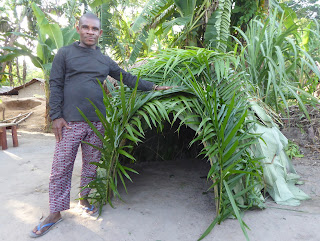more of the village
Having experienced the water-drumming, and seen a hint of the other music (the saucepan lid in use as a drum), I made another visit to the village, this time having arranged with the same staff member to spend the night there. So he organised the building of a hut for me – above, with him posing by the entrance!
I said that I wanted as authentic an experience as possible, so did not bring my own food, bedding or anything else from outside – apart from my insect repellent.
Initially I just sat with the colleague, asking him questions about the village and the Ba’aka way of life – an interesting conversation. He told me a little of his early life, revealing, for example, that elephant tastes like beef … but he also noted how pleased he was that the area is now protected (meaning that hunting of elephants, gorillas and chimpanzees is now illegal), and how the work of the WWF is helping to preserve their traditional way of life. I learnt that many of the Ba’aka wear amulets around their waists and sometimes arms, to protect them from evil spirits, and that yes, there are sacred trees and other spots, but only those with special powers know where they are. I got to visit the new house he is building, learn about the construction of both those branch, bamboo and mud houses and the more traditional stick and leaf huts.
Whilst we talked, the women were preparing dinner – pounded cassava with some kind of leaves from the forest, that taste rather like strong spinach.It wasn’t exactly a gourmet dish, but as I could see that the rest of the family were eating the same food, I was satisfied that I was getting the real, authentic experience.
We could hear some music underway somewhere else in the village, so he said it was time to hand over some ‘motivation’ (ie some cash with which they could buy some palm wine) so that other musicians would come to us to play. They set up outside my hut, near a campfire, with their musical instruments (the saucepan lid and bamboo drumsticks, and a couple of different-sized empty jerrycans), and as the light dimmed, some women came and sat beside the campfire.
The drumming started and some of the women stood up and danced a little, singing in their traditional way which I don’t have the words to describe. I can just say that it’s nothing like the kind of singing we hear in the west. Then an argument seemed to start, with one woman gesticulating wildly and kind of shouting at the others (although their language sounds so musical to my ears that it wasn’t that different from the singing), who shouted back ... but the shouts took on a rhythmic quality and some of the women were clapping in a rhythm that meshed with the drumming … and I realised that this was all part of the performance. My colleague tried to explain – something about a carpenter going into the forest, and a mouse, and the carpenter destroying some of the trees, and then something about flying squirrels, and river turtles … I gave up, told him he’d have to explain to me later, back in the quiet of the lodge, as I settled down to enjoy the experience.
We let them go on for more than two hours (the women, having emptied some of the little sachets of gin one can buy here, were getting more and more animated and probably could have gone on all night), but then tiredness overtook us and we indicated that they could stop. I found a place to pee where I didn’t think I’d be seen, and retired to my hut. To sleep on the bare earth, with the sounds of drumming and partying from other corners of the village (the drumming going on until after 5am, although far enough away not to be too disturbing), and with lots mosquitoes whining past my ears and biting me. Or rather, I tried to sleep, as I discovered (as half-expected) that I don’t have enough padding over my bones to lie on the hard earth. But it didn’t matter, I just wanted the experience of staying in the village, living as the locals do, for a night, and it was well worth the tiredness I felt the next day!






Comments
Post a Comment